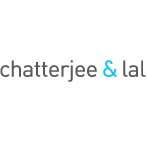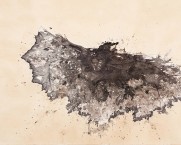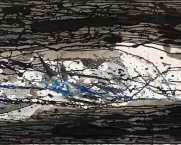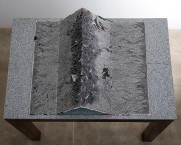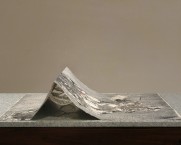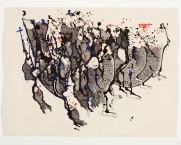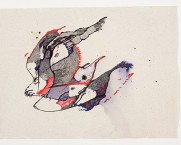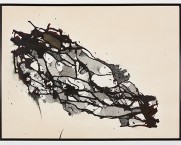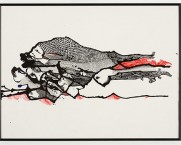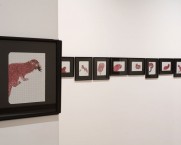C&L Shows
War with the stars
Minam Apang
2008
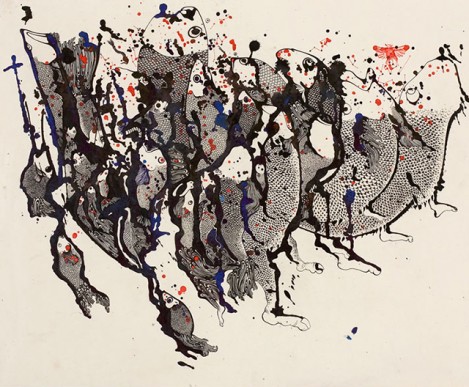
Overview
Artist Statement
The works in this series frame a visual re-reading that draws on the liquid worlds of myths in which the elements of the narrative are not restricted by formulaic structure or logic.
The point of departure for the works comprising War with the Stars was one specific story: a myth (re-told by Verrier Elwin in, Myths from the North East India) that weaves a tale of betrayal and revenge…
There was a time when the fish people and star people used to intermarry. This story begins one day when the there was trouble in the land of the stars. They needed to perform an animal sacrifice. Traps were set to catch a scapegoat. It was the otter who happened to walk into the trap. The star people decided to sacrifice the otter as there was no more time to lose – knowing full well that this would enrage the fish people. And who should have witnessed this dreadful act of betrayal but the bat. The star people sought to appease the bat – they wined him and dined him and pleaded with him not to disclose their secret to the star people. The bat satiated with food and alcohol agreed. But the sacrificed head of the otter only jeered. He burst out laughing when he heard the bat’s promise. Perhaps the otter in his wisdom in death foreshadowed the consequences of this turn of events.
Sure enough a while later the bat attempts to enter the land of the fish people. He is barred entry, “We are in mourning for Brother Otter who is dead,” they said. “You cannot enter. There are taboos to be followed in our period of mourning.” “What do you know about death,” the bat scoffed. “I can tell you things that will come as a revelation.” The fish people were intrigued and invited the bat in, but the bat would not relent so easily. The fish people too wined him and dined him till the alcohol loosened his tongue and he revealed to them the details of how the star people killed brother otter.
Of course the fish people are furious, call a council of all creatures on land, water and sky, and prepare to wage a war with the stars. This is why on stormy nights the fish come up to the surface of the water for the epic, unending war with the stars.
The myths change from village to village and are often puzzling. They often begin in media-res with no explanations of what preceded or what came to follow. What was the crises that befell the star people that necessitated the sacrifice? Why is the otter one of the fish people when otters eat fish for food? This is a world where a woman is impregnated by plant seed carried into her by a gust of wind. She bears a cricket for a baby, who cannot survive the heat in the land of the sun… Another story speaks of how the wind is born from the accidental killing of the limbless child of Pedong Nane (Rain Grandmother/Aunt). Cane sprouts from where Pedong Nane dies. Characters die and re-appear ad nauseum, beginnings and endings are indistinguishable.
Much of my work draws from a feeling of dislocation and the need to make sense of the many contexts I have come to occupy. I went to school in Mussoorie, with a distinctly Christian upbringing. I would come home to Arunachal where we follow ‘pagan’, animistic practices and tribal rituals. The two belief systems were, on the surface, very disparate. The contradiction has been something i have wrestled with and tried to make sense of for a long time. Much of my works are an expression of this process of reclaiming my own sense of location. The disconnected, non-linear dream-vocabulary of myths and folktales offered me a form of expression ideally suited to my hybrid teleology. The fluid structure allows for inverted realities and multiple tellings.
Although I had heard these stories growing up, I was re-acquainted with them as an adult in the form of printed texts. Perhaps that is why this work has text appearing in the works themselves. Deliberately indecipherable the text undulates to imitate the contours of mountain faces, and crashing waves. The words and meanings are here reclaimed and reinvented to people my landscapes that in turn are composed public histories and personal associations. A space where the reader enters with her own predispositions to add another layer to myriad readings this composite world accommodates.
As most origin myths, many of these stories may be seen as an early understanding of our relationship to the environment. I deliberately chose myths from Arunachal as a point of connection back to a history that is inevitably changing rapidly. Stories were traditionally conveyed orally; in extension of this gesture is my own visual telling as my contribution to this eternal flux of transmitted histories.
